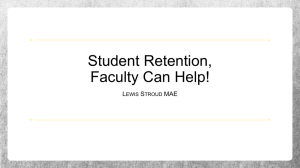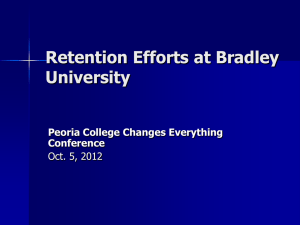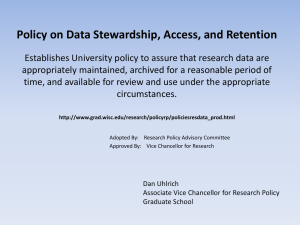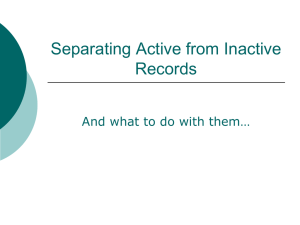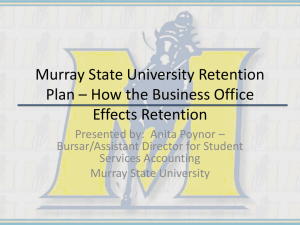DMD New York 2005 - Database marketing Institute
advertisement
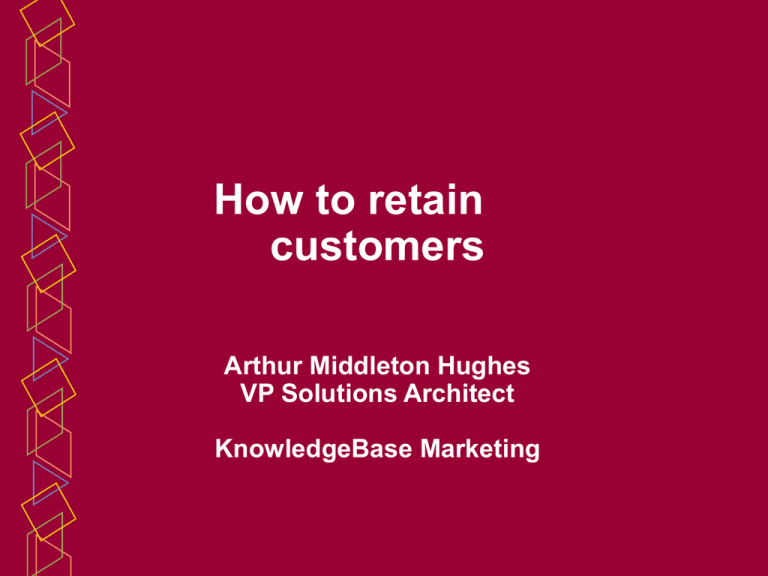
How to retain customers Arthur Middleton Hughes VP Solutions Architect KnowledgeBase Marketing A complete customer retention plan • Why customer retention is important • Methods of retention – Recruit right ones to start with – Communicate with them & reward them • Create segments • Predict attrition – Risk Revenue Matrix • Create a loyalty program – Sell them a second product – Get them to become multi-channel buyers • Evaluation of Retention Programs – Tests and Controls – Return on investment Why retention is important • Long term loyal customers: – – – – – – – Buy more per year Buy higher priced options Buy more often Are less price sensitive Are less costly to serve Are more loyal Have a higher lifetime value Retention is the way to measure loyalty 90% 80% 70% Percentage Retained from Previous Year 60% 50% 40% 30% 20% 10% 0% 1 2 3 4 Years as a customer 5 Retention pays better than acquisition. $100 spent returns: Annual Profit $48 $60 $40 $20 $0 ($20) ($40) ($60) ($80) ($62) New Customer 3rd Year Customer Basic Retention Strategy Rule: Put yourself in customer shoes Say: “What would I want to be on this database? What’s in it for me?” If you can’t come up with a good answer, the database will fail Methods of Retention – Recruit right ones to start with – Communicate with them & Reward them • Create segments • Predict attrition – Risk Revenue Matrix • Create a loyalty program Who are likely to be loyal? • Reichheld points out that – Some customers are loyal – others not – Begin by recruiting the right ones • One insurance company found that disloyal customers were: – – – – – – Transient individuals Young people, rather than older people Single people, rather than married people Renters, rather than homeowners. People who respond to low-ball discount offers People who respond to temporary sales Recruit relationship buyers Relationship Vs Transaction Buyers 120 Transaction Buyers 100 80 60 Relationship Buyers 40 20 0 Company A Company B Company C Company D • Transaction buyers only interest is price • Relationship buyers want a firm that gives good service to whom they can be loyal How to find relationship buyers • Lowball offers will attract transaction buyers • You cannot make a profit from them • Relationship buyers are interested in good service, high value and two way loyalty • They will stick with you and provide a profitable bottom line Methods of Retention – Recruit right ones to start with – Communicate with them & reward them • Create segments • Predict attrition- Risk Revenue Matrix • Create a loyalty program has a one-to-one customer communications program. • Results: Retention goes up 5.6 points • Travelers gains $14,000 per year per agent • Agents gain $2,380 per year The annual program • Letter 60 days before annual renewal • Annual review • Thank you card in 1st quarter • Cross sell postcard in 2nd quarter • Newsletter in 3rd quarter • Seasonal card in 4th quarter The value of a conversation with insurance customers • 62% of customers who leave, never talk to an agent first • 80% of people who talk to an agent do not leave. Restaurant chain sent $5 reward cards to 4,000 lapsed customers • Average member visits went from 25 per day before the promotion, to 42 per day. • Average visits per card went from 1.18 before to 1.26 during and 1.22 after the promotion. • Incremental sales were $17,100 during the promotion and $4,700 in the 35 days after the promotion was over. • Communications increased sales and retention. Methods of Retention – Recruit right ones to start with – Communicate with them & reward them • Create segments • Predict attrition – Risk Revenue Matrix • Create a loyalty program Creating customer segmentsMany are unprofitable 79.67% This 28% lost 22% of the bank’s profits! 80.00% 60.00% 24.82% 40.00% 15.83% 1.52% 20.00% 0.00% -20.00% Bank Customers by Profitability -21.83% -40.00% 5% 11% 28% 28% 28% Marketing to Customer Segments Your Best Customers 80% of Revenue Your Best Hope for New Gold Customers 1% of Total Revenue GOLD Move Up These may be losers Spend Service Dollars Here Spend Marketing Dollars Here Reactivate or Archive A ideal segment: • Has definable characteristics • Is large enough to justify a custom marketing strategy with appropriate rewards and budget • Has members who can be motivated • Makes efficient use of available data • Can be measured in performance • Justifies an organization devoted to it. Can be part of a person’s time, but there should be someone who “owns” each segment. Strategy for each segment: • Communications to the segment (direct mail, email, on-location personal attention) • Rewards designed to modify behavior • Controls to measure the success of the strategy • A budget for implementation of the strategy • Specific goals and metrics for engagement: for behavior modification • An organization that accepts responsibility for the segment Segments and Status Levels How one women’s chain segments their customers Methods of Retention – Recruit right ones to start with – Communicate with them & reward them • Create segments • Predict attrition- Risk Revenue Matrix • Create a loyalty program Methods of Retention – Recruit right ones to start with – Communicate with them & reward them • Create segments • Predict attrition- Risk Revenue Matrix • Create a loyalty program Who is going to defect? • Besides LTV, you can develop a model that predicts which customers are most likely to leave. • Putting that model with LTV you can refocus your entire retention strategy • You create a Risk Revenue Matrix Focus retention programs on A and B: 44% of your customers. LTV High Medium Low Probability of Leaving Soon High Medium Low Priority A Priority B Priority C Priority B Priority B Priority C Priority C Priority C Priority C Using Risk Revenue Matrix • Telecom company sent special messages to priorities A and B. • Ignored customers in priority C • Result: Boost in retention and profits Further results… Methods of Retention – Recruit right ones to start with – Communicate with them & reward them • Create segments • Predict attrition- Risk Revenue Matrix • Create a loyalty program What is a loyalty program? • A system whereby a customer has specifically signed up for a program. • She may receive a plastic card with her name on it. • The card is used whenever she shops in a retail store, on the phone or on the web. • The card provides her with some benefit she could not get without the card. • It provides you with valuable information that you can use to understand the customer and build her loyalty. Who participates in loyalty programs? • Parago (www.parago.com) found that high income households ($125K and more), participated much more in loyalty programs than the average household. Notable participation rates were: • Airline Frequent Flyer Programs 92% • Hotel Frequent Guest Programs 79% • Credit Card Rewards 71% • Retail Store Programs 44% How do loyalty programs boost retention? • Program permits you to keep track of customer behavior • You can see if valuable customers are reducing their orders or spending • You can proactively call them, write them, or make them offers Telecom company rewards program results: A complete customer retention plan • Methods of retention – – – – Recruit right ones to start with Communicate with them and reward them Sell them a second product Get them to become multi-channel • Evaluation of Retention Programs The value of a second product Retention Rate by Products Owned 90% 80% 70% 60% 50% 40% 30% 20% 10% 0% 1 2 3 4 Number of Products Owned 5+ Next Best Product • Collaborative Filtering can be used to determine for each customer her next most likely product. • Customer service and the web have this info available whenever a customer visits or calls. • Tests with GUS, largest cataloger in the UK, resulted in doubling the cross sale rate (from 20% to 40%) using the next best product on the telemarketers screens Cross sales build retention • Customers who have more than one product have a higher retention rate. • Two reasons for second product: – Profit from the new product – Retain customers for the existing one. • An insurance company with independent agents used a model to predict the Next Best Product for each customer • Offered a 10% discount on first product if second is purchased Selling a second insurance product Automatic follow up note How did it work out? • 89% of agents invited went to web and participated. • 52% created personal notes • Recipient HH bought 11% more than the controls • Follow up letter created 8% more sales • Follow up phone gained 43% more. A complete customer retention plan • Methods of retention – – – – Recruit right ones to start with Communicate with them and reward them Sell them a second product Get them to become multi channel • Evaluation of Retention Programs Multi-channel users are more loyal Retention Rate Year 2 Catalog, retail, web Catalog & Web Retail and Web Retail & Catalog Web Only Catalog Only Retail Only 0% 10% 20% 30% 40% 50% Illustrative numbers from several case studies 60% 70% 80% Why the web is important to retention • Web customers are more affluent • Their average order size is 12% higher than phone orders. • The cost of the web order is 16% lower than phone orders. • Typical incentive offered is 5% off on any order over $50. • Result: 11% of non web customers shift to the web every year. Creating a club on the internet • A company selling sporting goods created an internet member club. • When DB was built they learned that: – Club members bought 11 times more than non club members. – In two years, 81% of club members became multibuyers. – The club boosted retention Club Members Retention 80.5% 90.0% Conversion to MultiBuyers after two years 80.0% 70.0% 60.0% 23.4% 50.0% 40.0% 30.0% 20.0% 10.0% 0.0% Goal Club Non Goal Club Cataloger Customer Retention • Miles Kimball sent 20,000 emails with three different catalogs, and 20,000 with the three catalogs alone. • Those who got the emails bought 18% more than those who got the catalogs alone. 118 120 115 110 105 100 100 95 90 Control Test More sales = Higher overall retention levels Retailer Customer Retention • Video retailer sent email newsletters to 170,000 customers for 6 months. • Control group of 14,000 got no emails • Retail sales to test group was 28% more than to those without emails. 128 140 100 120 100 80 60 40 20 0 Control Test More sales = Higher overall retention levels One Click Ordering • With the web we use cookies to say, “Welcome back Susan”. • We keep her credit card on file if she wants so she can do one click ordering • Result, compared to controls, is higher retention and annual revenue from those who have one click ordering available. A complete customer retention plan • Evaluation of Retention Programs – Tests and Controls – Return on investment Why controls are essential • The sales force acquires new customers • Database marketers create higher retention rates • How do you prove this? • Retention program effectiveness can only be measured using control groups Every marketing promotion should always be a test • Test those who get the promotion against the performance of those who do not get the promotion • If you are sending birthday cards or a newsletter, select 50,000 who do not get birthday cards or the newsletter. • Look at the control’s spending rate, and retention rate. • If there is no difference, your cards or newsletters are a waste of money. What to measure • Attrition and retention of both groups • Migration upward and downward • Incremental sales per program and per season • Frequency of purchases • Dollars spent per trip and per season • Number of departments shopped • Number of items purchased • Share of customers’ wallet A complete customer retention plan • Evaluation of Retention Programs – Tests and Controls – Return on investment Retention Strategies to be quantified • Find out who your Gold customers are, and keep them loyal • Reward customer loyalty, resulting in increased retention • Increase purchases and average order size • Profile your customers, and acquire new ones with the same profile • Personalize customer’s web and phone experience Illustration: Birthday Gift • Get customers to record their birthdays with their emails. • On their birthday, send them a birthday Pizza Coupon • One fast food restaurant offered a $10 birthday coupon to 215,000 customers. • Of the coupons sent out, 86,612 were redeemed ($866,120) producing overall sales of $2,900,000 – a sales increase of $2 million. Illustration: Corporate collaboration Hewlett Packard tested an on line survey to promote their network printers. Direct mail drove responders to a web site that contained the survey. Responders received $10 in Pizza Hut coupons. The survey provided a special HP offer for network printing solutions, product links, and esubscription information. Live Agent • 74% of shopping carts abandoned at checkout. • Reason: customers have some question. They are unsure about the product, service, color, delivery, etc. • Solution: put a live chat button at checkout time. • Have live agents available to answer questions. • Result: increased retention and sales Caller ID • Use Caller ID to bring customer’s complete purchasing history on the screen before the agent begins talking. • Result, she can talk to the customer as if she knew her. • Result: Increased retention. Greater opportunity for cross sales. Putting It All Together: 1 2 3 4 5 6 7 8 9 10 Strategy Phone Calls Personalized Letters Personalized Email Email Newsletters Gold Member Services Loyalty Program Birthday Club Shift to Multi Channel Next Best Product Segment Strategies All Customer Impact % Sales or Percent Customers Customers Affected Responding 10% 10.00% 30% 5.00% 20% 5.00% 20% 5.00% 5% 40.00% 40% 10.00% 20% 5.00% 20% 10.00% 80% 5.00% 60% 3.00% 30.5% 19.60% % Change in Retention 1.00% 1.50% 1.00% 1.00% 2.00% 4.00% 1.00% 2.00% 4.00% 1.80% 19.30% % Change Orders/ Year 1.00% 1.50% 2.00% 2.00% 1.00% 4.00% 4.00% 2.00% 4.00% 1.80% 23.30% % Change Average Order 1.00% 1.50% 4.00% 4.00% 2.00% 4.00% 5.00% 2.00% 4.00% 1.80% 29.30% • An average of 19% of customers respond to one or more strategies • The overall retention rate goes up by 19.3% • Orders per year and average order size also increase significantly • These numbers are illustrative. You can create your own numbers using tests and controls Annual costs of the strategies Strategy Phone Calls Personalized Letters Personalized Email Email Newsletters Gold Member Services Loyalty Program Birthday Club Shift to Multi Channel Next Best Product Segment Strategies Total % Sales or Percent Annual Customers Customers Customer Total Affected Responding Investment Customers 10% 10.00% $3.00 200,000 30% 5.00% $1.50 200,000 20% 5.00% $0.06 200,000 20% 5.00% $0.10 200,000 5% 40.00% $5.00 200,000 40% 10.00% $4.00 200,000 20% 5.00% $1.00 200,000 20% 10.00% $1.00 200,000 80% 5.00% $0.10 200,000 60% 3.00% $0.40 200,000 Total Annual Costs $60,000 $90,000 $2,400 $4,000 $50,000 $320,000 $40,000 $40,000 $16,000 $48,000 $670,400 What should you do to increase retention? – – – – – – – – Recruit right customers to start with Communicate with them & reward them Determine their lifetime value Create customer segments with a marketing strategy for each segment Sell them a second product Get them to become multi-channel buyers Use Tests and Controls Calculate return on investment Books by Arthur Hughes From McGraw Hill. Order at www.dbmarketing.com Contact Arthur: arthur.hughes@kbm1.com Thank you!
